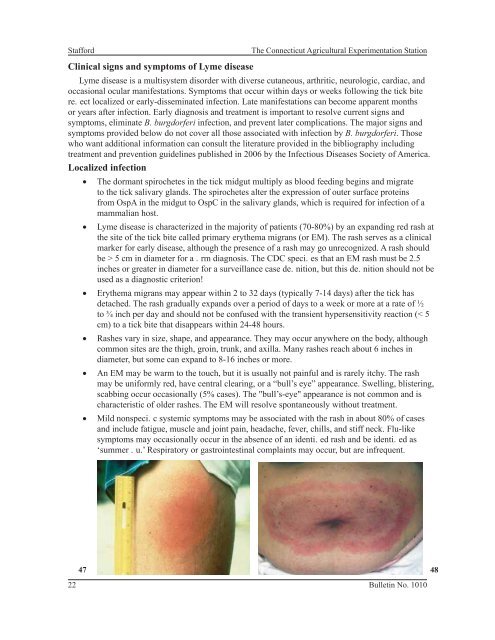Dr. Stafford Tick Management Handbook - Newtown, CT
Dr. Stafford Tick Management Handbook - Newtown, CT
Dr. Stafford Tick Management Handbook - Newtown, CT
Create successful ePaper yourself
Turn your PDF publications into a flip-book with our unique Google optimized e-Paper software.
<strong>Stafford</strong>Clinical signs and symptoms of Lyme diseaseThe Connecticut Agricultural Experimentation StationLyme disease is a multisystem disorder with diverse cutaneous, arthritic, neurologic, cardiac, andoccasional ocular manifestations. Symptoms that occur within days or weeks following the tick bitere. ect localized or early-disseminated infection. Late manifestations can become apparent monthsor years after infection. Early diagnosis and treatment is important to resolve current signs andsymptoms, eliminate B. burgdorferi infection, and prevent later complications. The major signs andsymptoms provided below do not cover all those associated with infection by B. burgdorferi. Thosewho want additional information can consult the literature provided in the bibliography includingtreatment and prevention guidelines published in 2006 by the Infectious Diseases Society of America.Localized infection• The dormant spirochetes in the tick midgut multiply as blood feeding begins and migrateto the tick salivary glands. The spirochetes alter the expression of outer surface proteinsfrom OspA in the midgut to OspC in the salivary glands, which is required for infection of amammalian host.• Lyme disease is characterized in the majority of patients (70-80%) by an expanding red rash atthe site of the tick bite called primary erythema migrans (or EM). The rash serves as a clinicalmarker for early disease, although the presence of a rash may go unrecognized. A rash shouldbe > 5 cm in diameter for a . rm diagnosis. The CDC speci. es that an EM rash must be 2.5inches or greater in diameter for a surveillance case de. nition, but this de. nition should not beused as a diagnostic criterion!• Erythema migrans may appear within 2 to 32 days (typically 7-14 days) after the tick hasdetached. The rash gradually expands over a period of days to a week or more at a rate of ½to ¾ inch per day and should not be confused with the transient hypersensitivity reaction (< 5cm) to a tick bite that disappears within 24-48 hours.• Rashes vary in size, shape, and appearance. They may occur anywhere on the body, althoughcommon sites are the thigh, groin, trunk, and axilla. Many rashes reach about 6 inches indiameter, but some can expand to 8-16 inches or more.• An EM may be warm to the touch, but it is usually not painful and is rarely itchy. The rashmay be uniformly red, have central clearing, or a “bull’s eye” appearance. Swelling, blistering,scabbing occur occasionally (5% cases). The "bull’s-eye" appearance is not common and ischaracteristic of older rashes. The EM will resolve spontaneously without treatment.• Mild nonspeci. c systemic symptoms may be associated with the rash in about 80% of casesand include fatigue, muscle and joint pain, headache, fever, chills, and stiff neck. Flu-likesymptoms may occasionally occur in the absence of an identi. ed rash and be identi. ed as‘summer . u.’ Respiratory or gastrointestinal complaints may occur, but are infrequent.47 4822Bulletin No. 1010











